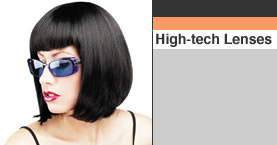|
Specialty Lens Coatings
Anti-reflective
Coatings
Ultraviolet Coatings
Scratch-resistant Coatings
Normal
lenses have surface reflections because light transmission through
the lens is only about 94%(all thin lenses are more reflective and
transmit only about 90%). Loss of the remaining 6% - 10%occurs as
light bounces off the front and back surfaces. We are familiar with
this when we remember looking at our reflection of ourselves in
a window, especially when it is dark outside. This is also why we
can see our eyes or cheeks in the backside of glasses lenses. Until
recently the only thing to do about these reflections was to try
and adjust the frames to redirect the bounce-back of light, change
the curve of the lens or even change the prescription. Very little
helped.
What changed for the best was the introduction of anti-reflective
coatings. AR is a series of multi-layers of metallic oxides that
when applied to the surface of lenses eliminates reflections by
increasing the transmission of light to almost 99.5%. With this
coating lenses are almost completely transparent which helps with
not only improving the cosmetics of glasses (how we are seen in
glasses with reflections) but also the way we see through the lenses.
No more seeing our eyes and cheeks on the inside of the lenses,
no more seeing ghost images and shadows of lights and no more multiple
images of oncoming headlights while driving at night. One of the
reasons contact lens wearers like the way they see through them
is because there are no reflections getting in the way of their
view of the world. AR coated lenses rival the transparency of contacts.
This is probably the most important introduction in the world of
glasses since the arrival of plastic lens materials.
Because light transmission is now so high, anything interfering
with the surface shows up on the lenses. Dust, smudges and fingerprints
will be more noticeable. The way to keep lenses clean is simple.
Just wash them with a mild soap and warm water and dry them with
a soft cotton cloth. The best soap is liquid dish soap or shampoo.
These cut grease without leaving any film and will not harm the
lens or coating. We also supply micro-fiber cleaning cloths that
are great when the lenses get smudged and you are not around any
water. With the cloth lightly wipe the front and back surface of
the lens to first remove any dust or grit. Then after shaking the
cloth to remove the debris rub the lenses to remove the fingerprints
or smudges. The cloths should be washed to prevent the buildup of
skin oils and dust.
Home
| Ask Dr. Chet | Site
Map | Copyrights
| Privacy
Policy
|



